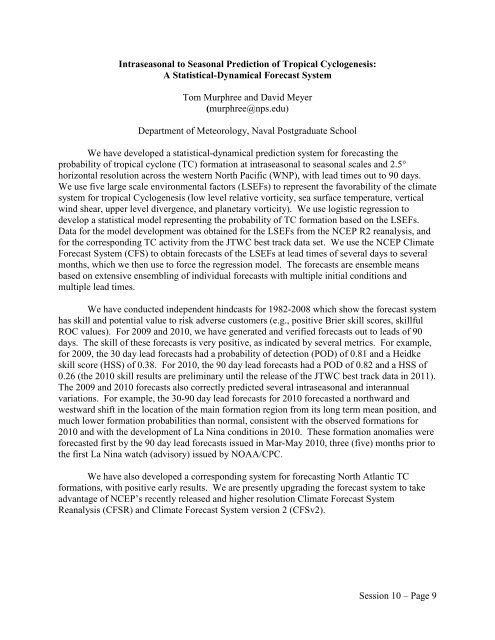65th IHC Booklet/Program (pdf - 4.9MB) - Office of the Federal ...
65th IHC Booklet/Program (pdf - 4.9MB) - Office of the Federal ...
65th IHC Booklet/Program (pdf - 4.9MB) - Office of the Federal ...
You also want an ePaper? Increase the reach of your titles
YUMPU automatically turns print PDFs into web optimized ePapers that Google loves.
Intraseasonal to Seasonal Prediction <strong>of</strong> Tropical Cyclogenesis:<br />
A Statistical-Dynamical Forecast System<br />
Tom Murphree and David Meyer<br />
(murphree@nps.edu)<br />
Department <strong>of</strong> Meteorology, Naval Postgraduate School<br />
We have developed a statistical-dynamical prediction system for forecasting <strong>the</strong><br />
probability <strong>of</strong> tropical cyclone (TC) formation at intraseasonal to seasonal scales and 2.5°<br />
horizontal resolution across <strong>the</strong> western North Pacific (WNP), with lead times out to 90 days.<br />
We use five large scale environmental factors (LSEFs) to represent <strong>the</strong> favorability <strong>of</strong> <strong>the</strong> climate<br />
system for tropical Cyclogenesis (low level relative vorticity, sea surface temperature, vertical<br />
wind shear, upper level divergence, and planetary vorticity). We use logistic regression to<br />
develop a statistical model representing <strong>the</strong> probability <strong>of</strong> TC formation based on <strong>the</strong> LSEFs.<br />
Data for <strong>the</strong> model development was obtained for <strong>the</strong> LSEFs from <strong>the</strong> NCEP R2 reanalysis, and<br />
for <strong>the</strong> corresponding TC activity from <strong>the</strong> JTWC best track data set. We use <strong>the</strong> NCEP Climate<br />
Forecast System (CFS) to obtain forecasts <strong>of</strong> <strong>the</strong> LSEFs at lead times <strong>of</strong> several days to several<br />
months, which we <strong>the</strong>n use to force <strong>the</strong> regression model. The forecasts are ensemble means<br />
based on extensive ensembling <strong>of</strong> individual forecasts with multiple initial conditions and<br />
multiple lead times.<br />
We have conducted independent hindcasts for 1982-2008 which show <strong>the</strong> forecast system<br />
has skill and potential value to risk adverse customers (e.g., positive Brier skill scores, skillful<br />
ROC values). For 2009 and 2010, we have generated and verified forecasts out to leads <strong>of</strong> 90<br />
days. The skill <strong>of</strong> <strong>the</strong>se forecasts is very positive, as indicated by several metrics. For example,<br />
for 2009, <strong>the</strong> 30 day lead forecasts had a probability <strong>of</strong> detection (POD) <strong>of</strong> 0.81 and a Heidke<br />
skill score (HSS) <strong>of</strong> 0.38. For 2010, <strong>the</strong> 90 day lead forecasts had a POD <strong>of</strong> 0.82 and a HSS <strong>of</strong><br />
0.26 (<strong>the</strong> 2010 skill results are preliminary until <strong>the</strong> release <strong>of</strong> <strong>the</strong> JTWC best track data in 2011).<br />
The 2009 and 2010 forecasts also correctly predicted several intraseasonal and interannual<br />
variations. For example, <strong>the</strong> 30-90 day lead forecasts for 2010 forecasted a northward and<br />
westward shift in <strong>the</strong> location <strong>of</strong> <strong>the</strong> main formation region from its long term mean position, and<br />
much lower formation probabilities than normal, consistent with <strong>the</strong> observed formations for<br />
2010 and with <strong>the</strong> development <strong>of</strong> La Nina conditions in 2010. These formation anomalies were<br />
forecasted first by <strong>the</strong> 90 day lead forecasts issued in Mar-May 2010, three (five) months prior to<br />
<strong>the</strong> first La Nina watch (advisory) issued by NOAA/CPC.<br />
We have also developed a corresponding system for forecasting North Atlantic TC<br />
formations, with positive early results. We are presently upgrading <strong>the</strong> forecast system to take<br />
advantage <strong>of</strong> NCEP’s recently released and higher resolution Climate Forecast System<br />
Reanalysis (CFSR) and Climate Forecast System version 2 (CFSv2).<br />
Session 10 – Page 9
















